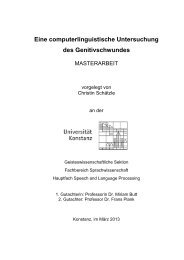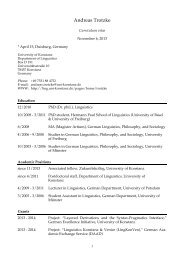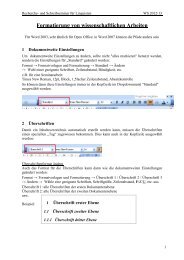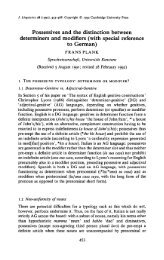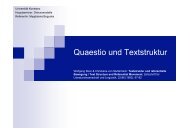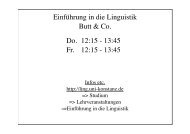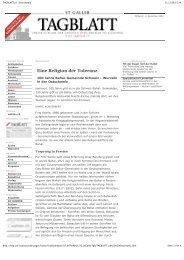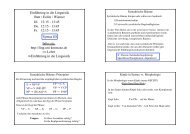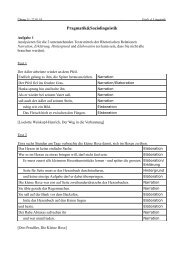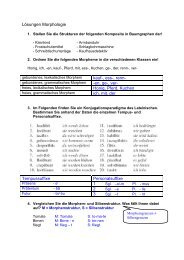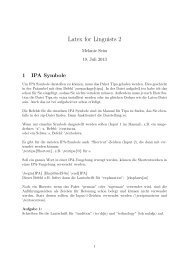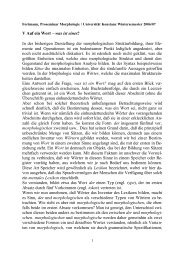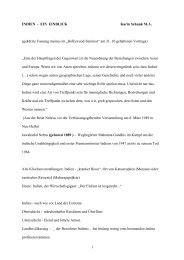1 Negative Indefinites in Dutch and German Doris Penka & Hedde ...
1 Negative Indefinites in Dutch and German Doris Penka & Hedde ...
1 Negative Indefinites in Dutch and German Doris Penka & Hedde ...
You also want an ePaper? Increase the reach of your titles
YUMPU automatically turns print PDFs into web optimized ePapers that Google loves.
1. Introduction<br />
<strong>Negative</strong> <strong>Indef<strong>in</strong>ites</strong> <strong>in</strong> <strong>Dutch</strong> <strong>and</strong> <strong>German</strong><br />
<strong>Doris</strong> <strong>Penka</strong> & <strong>Hedde</strong> Zeijlstra<br />
{d.penka | hedde.zeijlstra}@uni-tueb<strong>in</strong>gen.de<br />
<strong>Negative</strong> <strong>Indef<strong>in</strong>ites</strong> (NIs), such as English nobody, noth<strong>in</strong>g or no boy, are generally<br />
considered to be generalized quantifiers that are semantically negative:<br />
(1) [[nobody]] = λP.¬∃x[body’(x) & P(x)] or equivalently<br />
[[nobody]] = λP.∀x[body’(x) → ¬P(x)]<br />
However, there are two different phenomena that challenge this analysis. The first has<br />
been extensively discussed <strong>in</strong> the literature <strong>and</strong> is known as <strong>Negative</strong> Concord; the<br />
second <strong>in</strong>volves split-scope read<strong>in</strong>gs of NIs, where the negative <strong>and</strong> the <strong>in</strong>def<strong>in</strong>ite part<br />
of NI take scope <strong>in</strong>dependently of each other. This will be the ma<strong>in</strong> topic of the paper.<br />
In most <strong>German</strong>ic languages two negative elements yield an affirmative as is<br />
shown <strong>in</strong> (2b). They are therefore called Double Negation (DN) languages.<br />
(2) a. Nobody calls.<br />
¬∃x[body’(x) & call’(x)]<br />
b. Nobody said noth<strong>in</strong>g.<br />
¬∃x¬∃y[body’(x) & th<strong>in</strong>g’(y) & say’(x, y)] =<br />
∀x∃y[body’(x) & th<strong>in</strong>g’(y) & say’(x, y)]<br />
But <strong>in</strong> many languages this is not the case. In Romance <strong>and</strong> Slavic languages for<br />
<strong>in</strong>stance multiple negative elements contribute one semantic negation only. This<br />
phenomenon is called <strong>Negative</strong> Concord (NC).<br />
(3) a. Non telefona nessuno. (Italian)<br />
NEG calls n-body<br />
1. *¬¬∃x[body’(x) & call’(x)] = ∃x[body’(x) & call’(x)]<br />
2. ¬∃x[body’(x) & call’(x)]<br />
b. Nessuno ha detto niente.<br />
1. *¬∃x¬∃y[body’(x) & th<strong>in</strong>g’(y) & say’(x, y)]<br />
= ∀x∃y[body’(x) & th<strong>in</strong>g’(y) & say’(x, y)]<br />
2. ¬∃x∃y[body’(x) & th<strong>in</strong>g’(y) & say’(x, y)]<br />
(4) a. Nevolá nikdo. (Czech)<br />
NEG.calls n-body<br />
1. *¬¬∃x[body’(x) & call’(x)] = ∃x[body’(x) & call’(x)]<br />
2. ¬∃x[body’(x) & call’(x)]<br />
b. Nikdo nedá nikomu nic.<br />
N-body NEG.gave n-body n-th<strong>in</strong>g<br />
1. *¬∃x¬¬∃y¬∃z[body’(x) & body’(y) th<strong>in</strong>g’(z) & give’(x, y, z)]<br />
= ∀x∀y∃z[body’(x) & body’(y) & th<strong>in</strong>g’(z) & give’(x, y, z)]<br />
2. ¬∃x∃y∃z[body’(x) & body’(y) th<strong>in</strong>g’(z) & give’(x, y, z)]<br />
1
Hence, the analysis <strong>in</strong> (1) faces problems for so-called NC languages. Because of data<br />
such as (3) <strong>and</strong> (4) many scholars have proposed that NIs <strong>in</strong> NC languages, such as<br />
Italian nessuno ‘n-body’ or niente ‘n-th<strong>in</strong>g’, are not negative quantifiers, but<br />
semantically non-negative <strong>in</strong>def<strong>in</strong>ites that st<strong>and</strong> <strong>in</strong> some relation with a (possibly<br />
abstract) negative operator (Ladusaw 1992, Giannakidou 1997, Zeijlstra 2004), thus<br />
argu<strong>in</strong>g aga<strong>in</strong>st analyses that take all NIs to be negative quantifiers (cf. Haegeman<br />
1995, Haegeman & Zanutt<strong>in</strong>i 1996, De Swart & Sag 2002).<br />
In this paper we discuss split-scope read<strong>in</strong>gs, which are exhibited by NIs <strong>in</strong><br />
DN languages. We expla<strong>in</strong> the possibility of such read<strong>in</strong>gs by argu<strong>in</strong>g that NIs <strong>in</strong> DN<br />
languages are not negative quantifiers.<br />
After <strong>in</strong>troduc<strong>in</strong>g the relevant data <strong>in</strong> the next section, we present an analysis<br />
of NIs <strong>in</strong> DN languages <strong>and</strong> apply it to the problematic cases. This analysis is then<br />
compared to previous accounts (section 4). In section 5, we discuss how our analysis<br />
of NIs relates to the phenomena of NC <strong>and</strong> negative polarity, result<strong>in</strong>g <strong>in</strong> a picture of<br />
the l<strong>and</strong>scape of licens<strong>in</strong>g relations between negation <strong>and</strong> <strong>in</strong>def<strong>in</strong>ites. Section 6<br />
concludes.<br />
2. Data<br />
In this section we discuss a phenomenon occurr<strong>in</strong>g <strong>in</strong> <strong>Dutch</strong> <strong>and</strong> <strong>German</strong> that<br />
challenges the view that NIs <strong>in</strong> these languages are negative quantifiers. This<br />
phenomenon was first noted <strong>in</strong> Bech (1955/57) <strong>and</strong> later discussed a.o. <strong>in</strong> Jacobs<br />
(1980) for <strong>German</strong> <strong>and</strong> Rullman (1995) for <strong>Dutch</strong>. It is sometimes referred to as<br />
scope-splitt<strong>in</strong>g s<strong>in</strong>ce <strong>in</strong> the semantics the negation <strong>and</strong> the <strong>in</strong>def<strong>in</strong>ite mean<strong>in</strong>g<br />
component of NIs take scope <strong>in</strong>dependently of each other. This can be seen <strong>in</strong> some<br />
environments where the negation can take wide scope over some operator, while the<br />
<strong>in</strong>def<strong>in</strong>ite mean<strong>in</strong>g component has narrow scope. A split read<strong>in</strong>g is generally<br />
available for NIs embedded under modal or object <strong>in</strong>tensional verbs.<br />
2.1 Modal Verbs<br />
Consider the follow<strong>in</strong>g <strong>German</strong> example <strong>in</strong> which an NI is embedded under a modal<br />
verb:<br />
(5) Du musst ke<strong>in</strong>e Krawatte anziehen. (<strong>German</strong>)<br />
You must no tie wear<br />
a. ‘It is not required that you wear a tie.’ ¬ > must > ∃<br />
b. ‘There is no tie that you are required to wear.’ ¬ > ∃ > must<br />
c. ‘It is required that you don't wear a tie.’ must > ¬ > ∃<br />
The salient read<strong>in</strong>g of this sentence is paraphrased <strong>in</strong> (5)a. As can be read off from<br />
this paraphrase, the negation has wide scope over the modal, whereas the <strong>in</strong>def<strong>in</strong>ite<br />
has narrow scope. This read<strong>in</strong>g, however, cannot be derived under the assumption that<br />
the NI ke<strong>in</strong>e Krawatte is a pla<strong>in</strong> negative quantifier. The only read<strong>in</strong>gs the negative<br />
quantifier analysis derives are the ones paraphrased <strong>in</strong> (5)b <strong>and</strong> (5)c. In (5)c, the<br />
negative quantifier is <strong>in</strong>terpreted with surface scope <strong>and</strong> both the negation <strong>and</strong> the<br />
<strong>in</strong>def<strong>in</strong>ite have narrow scope with respect to the modal. This read<strong>in</strong>g, equivalent to<br />
‘you are not allowed to wear a tie’, is hard to get, <strong>and</strong> available only with lots of help<br />
2
from the context, because there is a strong tendency <strong>in</strong> <strong>German</strong> that negation<br />
outscopes modals (see de Haan, 1997). The only way the modal gets <strong>in</strong> the scope of<br />
the negation is LF-movement of the negative quantifier across the modal, result<strong>in</strong>g <strong>in</strong><br />
read<strong>in</strong>g (5)b, <strong>in</strong> which both the negation <strong>and</strong> the <strong>in</strong>def<strong>in</strong>ite outscope the modal. But<br />
the wide scope read<strong>in</strong>g has weak truth conditions: (5)b is true iff there is no specific<br />
tie that you are required to wear. This does not exclude that the occasion under<br />
discussion might require that you were some tie or other. This is contrary to<br />
<strong>in</strong>tuitions, accord<strong>in</strong>g to which the sentence <strong>in</strong> (5) rejects that ties are obligatory.<br />
The same l<strong>in</strong>e of argumentation carries over to the follow<strong>in</strong>g <strong>Dutch</strong> example<br />
(from Rullman 1995: 194):<br />
(6) Ze mogen geen verpleegkundige ontslaan. (<strong>Dutch</strong>)<br />
they may no nurse fire<br />
a. ‘They are not allowed to fire any nurse’ ¬ > may > ∃<br />
b. ‘There is no nurse who they are allowed to fire’ ¬ > ∃ > may<br />
c. ‘They are allowed not to fire a nurse’ may > ¬ > ∃<br />
The case for the split scope read<strong>in</strong>g can be made even stronger. In the context<br />
of expletive es ‘there’ an <strong>in</strong>def<strong>in</strong>ite embedded under a modal can only take narrow<br />
scope:<br />
(7) Es muss e<strong>in</strong> Arzt anwesend se<strong>in</strong>.<br />
there must a physician present be<br />
a. ‘It is required that there be a physician present.’ must > ∃<br />
b. *‘There is a physician who is required to be present.’ ∃ > must<br />
Similarily, an NI embedded under a modal <strong>in</strong> a there-<strong>in</strong>sertion context cannot take<br />
scope above the modal. But <strong>in</strong> the salient read<strong>in</strong>g, the negation nevertheless outscopes<br />
the modal.<br />
(8) Es muss ke<strong>in</strong> Arzt anwesend se<strong>in</strong>.<br />
there must no physician present be<br />
a. ‘It is not required that there be a physician present.’ ¬ > must > ∃<br />
b. *‘There is no physician who is required to be present.’ ¬ > ∃ > must<br />
c. ‘It is required that there be no physician present.’ must > ¬ > ∃<br />
These considerations show that the salient read<strong>in</strong>g cannot be somehow derived from<br />
the wide scope read<strong>in</strong>g of a negative quantifier, thereby confirm<strong>in</strong>g that scope<br />
splitt<strong>in</strong>g of NIs is real.<br />
2.2 Object Intensional Verbs<br />
Scope splitt<strong>in</strong>g also occurs when an NI is the object of a transitive <strong>in</strong>tensional verb<br />
like seek or owe, as demonstrated <strong>in</strong> the follow<strong>in</strong>g examples for <strong>German</strong> <strong>and</strong> <strong>Dutch</strong>,<br />
respectively.<br />
3
(9) Perikles schuldet Socrates ke<strong>in</strong> Pferd. (<strong>German</strong>)<br />
Perikles owes Socrates no horse<br />
a. ‘Perikles is not obliged to give Socrates a horse.’ ¬ > owe > ∃<br />
b. ‘There is no horse that P. is obliged to give to Socrates.’ ¬ > ∃ > owe<br />
c. *‘Perikles is obliged not to give Socrates a horse.’ owe > ¬ > ∃<br />
(10) Hans zoekt geen eenhoorn. (<strong>Dutch</strong>)<br />
Hans seeks no unicorn<br />
a. ‘Hans is not try<strong>in</strong>g to f<strong>in</strong>d a unicorn.’ ¬ > seek > ∃<br />
b. ‘There is no unicorn Hans is try<strong>in</strong>g to f<strong>in</strong>d.’ ¬ > ∃ > seek<br />
c. *‘Hans is try<strong>in</strong>g not to f<strong>in</strong>d a unicorn.’ seek > ¬ > ∃<br />
As before, the split scope read<strong>in</strong>g paraphrased <strong>in</strong> (a) is the salient one. Under<br />
<strong>in</strong>tensional verbs, the narrow scope read<strong>in</strong>g (c) is not available at all. While the wide<br />
scope read<strong>in</strong>g (b) is possible, it has weak truth conditions. (10)b for <strong>in</strong>stance is true if<br />
unicorns do not exist <strong>in</strong> the evaluation world, <strong>in</strong>dependently of Hans’ activities.<br />
3 Analysis<br />
The fact that the negative <strong>and</strong> the <strong>in</strong>def<strong>in</strong>ite part of an NI <strong>in</strong> DN languages such as<br />
<strong>Dutch</strong> <strong>and</strong> <strong>German</strong> may take scope from different positions requires an explanation.<br />
In this section we formulate a proposal that accounts for this problem. In short, we<br />
propose that <strong>in</strong> DN languages NIs can be complex lexical items consist<strong>in</strong>g of an<br />
abstract negative operator <strong>and</strong> a non-negative <strong>in</strong>def<strong>in</strong>ite. Hence, the relation between<br />
the <strong>in</strong>def<strong>in</strong>ite <strong>and</strong> Op ¬ is lexically fixed <strong>and</strong> the two elements enter the syntactic<br />
derivation together.<br />
In subsection 3.1 we elaborate this proposal <strong>in</strong> more detail <strong>and</strong> <strong>in</strong> the<br />
subsequent subsections we demonstrate how the different possible read<strong>in</strong>gs can be<br />
derived for the NIs <strong>in</strong> the environments discussed <strong>in</strong> section 2: modal verbs (3.2) <strong>and</strong><br />
<strong>in</strong>tensional verbs (3.3).<br />
3.1 NIs as complex lexical items<br />
It is often assumed that NIs lack an <strong>in</strong>ternal syntactic structure <strong>and</strong> that an NI is a<br />
simple lexical item. In other words, the semantics of an NI is that of a negative<br />
quantifier <strong>and</strong> its semantic force is <strong>in</strong>duced from one po<strong>in</strong>t <strong>in</strong> the syntactic structure.<br />
A simplified illustration is given <strong>in</strong> (11).<br />
(11) No car is red<br />
¬∃x[Car’(x) & Red’(x)]<br />
λP.λQ.¬∃x[P(x) & Q(x)] λx.Car’(x)<br />
4<br />
λx.Red’(x)
However, there is no reason to assume that the structure <strong>in</strong> (11) is the only way to<br />
generate the mean<strong>in</strong>g of a construction conta<strong>in</strong><strong>in</strong>g an NI. Moreover, although from a<br />
morphosyntactic perspective (11) consists of three lexical elements (not tak<strong>in</strong>g the<br />
copula <strong>in</strong>to account), on the semantic level it exhibits at least four dist<strong>in</strong>ct objects: the<br />
predicates car <strong>and</strong> red, the <strong>in</strong>def<strong>in</strong>ite <strong>and</strong> the negation. From this semantic po<strong>in</strong>t of<br />
view it seems far from unnatural to assume that all these objects express their<br />
semantic force from a different po<strong>in</strong>t <strong>in</strong> the syntactic structure, as shown <strong>in</strong> (12).<br />
S<strong>in</strong>ce (12) yields exactly the same read<strong>in</strong>g as (11), NIs do not have to be negative<br />
quantifiers: they can also be semantically non-negative, as long as there is some<br />
syntactic device that forces a negative operator to enter the derivation simultaneously.<br />
(12) No car is red<br />
¬∃x[Car’(x) & Red’(x)]<br />
Op ¬ ∃x[Car’(x) & Red’(x)]<br />
λP.λQ.∃x[P(x) & Q(x)] λx.Car’(x)<br />
5<br />
λx.Red’(x)<br />
The ma<strong>in</strong> difference between (11) <strong>and</strong> (12) is that the <strong>in</strong>def<strong>in</strong>ite <strong>and</strong> the negative<br />
operator occupy different positions <strong>in</strong> the structure. Consequently, the structure <strong>in</strong><br />
(12), contrary to the structure <strong>in</strong> (11), does not exclude other material to <strong>in</strong>tervene<br />
between the position of the negative operator <strong>and</strong> the <strong>in</strong>def<strong>in</strong>ite. How the structure <strong>in</strong><br />
(12) is derived will be the topic of this section.<br />
The more complex structure <strong>in</strong> (12) immediately raises two questions. First,<br />
how does it follow from the structure <strong>in</strong> (12) that the two different nodes, the negation<br />
<strong>and</strong> the <strong>in</strong>def<strong>in</strong>ite, are realized as one phonological object? Second, what is the<br />
relation between the negation <strong>and</strong> the <strong>in</strong>def<strong>in</strong>ite? In DN languages the relation<br />
between the negation <strong>and</strong> the <strong>in</strong>def<strong>in</strong>ite is always 1:1 (as opposed to NC languages,<br />
where accord<strong>in</strong>g to many scholars one negation may license multiple <strong>in</strong>def<strong>in</strong>ites).<br />
Hence it needs to be accounted for how it is possible that the two parts of the NI form<br />
one unit while simultaneously occupy<strong>in</strong>g two different structural positions.<br />
In order to address these questions, we propose that the complex structure of<br />
NIs is already realised with<strong>in</strong> the lexicon. Hence, rather than merg<strong>in</strong>g with an atomic<br />
object, the derivation is exp<strong>and</strong>ed with a piece of structure that has already been<br />
prefabricated <strong>in</strong> the lexicon. Now, the two problems immediately vanish: first, the fact<br />
that the complex structure receives one phonological realisation follows from the fact<br />
that the phonological features are mapped on the Lexical Item (LI) as such; second,<br />
the fact that the relation between the negative operator <strong>and</strong> the <strong>in</strong>def<strong>in</strong>ite is 1:1 is<br />
already determ<strong>in</strong>ed with<strong>in</strong> the lexicon. Licens<strong>in</strong>g of <strong>in</strong>def<strong>in</strong>ites by a negative operator<br />
can only take place with<strong>in</strong> the lexicon <strong>and</strong> therefore every NI <strong>in</strong>cludes the presence of<br />
a negative operator (Op ¬).
Given these considerations we argue that NIs <strong>in</strong> languages such as <strong>Dutch</strong> <strong>and</strong><br />
<strong>German</strong> are complex LIs that consist of a negative <strong>and</strong> an <strong>in</strong>def<strong>in</strong>ite part. An example<br />
is given <strong>in</strong> (13) for <strong>German</strong> ke<strong>in</strong> ‘no’.<br />
(13) Structure of LI ke<strong>in</strong>: 1<br />
ke<strong>in</strong><br />
Op ¬ e<strong>in</strong><br />
Before address<strong>in</strong>g the issue of how the structure <strong>in</strong> (12) is derived, we will first look<br />
at the consequences on the lexical, syntactic <strong>and</strong> semantic level of the assumption that<br />
NIs are complex LIs. On the lexical level it means that an NI is a structurally complex<br />
element rather than an atomic element. Note that this does not mean that all properties<br />
of the LI are necessarily mapped on one of its components. The phonological features<br />
of the NI for example belong to the LI as such, as well as its other formal features<br />
(such as its [Q] features). On the syntactic level the NI is a piece of syntactic structure<br />
that enters the derivation as a unit. Note that the NI forms one syntactic constituent<br />
that can be subject to syntactic operations such as Move. F<strong>in</strong>ally, on the semantic<br />
level the negative operator (Op ¬) <strong>and</strong> the <strong>in</strong>def<strong>in</strong>ite are two dist<strong>in</strong>ct semantic objects.<br />
This implies that, whereas the other grammatical components (phonology, syntax)<br />
respect the lexical <strong>in</strong>tegrity of the NI, semantics is bl<strong>in</strong>d to it.<br />
The different status of NIs with respect to syntax <strong>and</strong> semantics now enable us<br />
to derive a structure like that <strong>in</strong> (12) <strong>and</strong> thus get the spilt-scope read<strong>in</strong>g. In the next<br />
subsection we demonstrate how the different read<strong>in</strong>gs of sentences consist<strong>in</strong>g of a<br />
modal verb <strong>and</strong> an NI follow. In the section thereafter we show <strong>in</strong> a similar fashion<br />
how the different read<strong>in</strong>gs come about <strong>in</strong> sentences with an object <strong>in</strong>tensional verb.<br />
3.2 Deriv<strong>in</strong>g the split-scope read<strong>in</strong>gs: modal verbs<br />
Let us reconsider the data <strong>in</strong> (5) <strong>and</strong> (6) ((5) is repeated as (14) below, abstract<strong>in</strong>g<br />
away from V2 movement). The sentence has three read<strong>in</strong>gs, paraphresed (14)1-3,<br />
with the first one be<strong>in</strong>g the most salient.<br />
(14) …dass du ke<strong>in</strong>e Krawatte anziehen musst<br />
…that you no tie wear must<br />
1. ‘… that it is not obligatory that you wear a tie’ ¬ > must > ∃<br />
[Op ¬[IP you [I must [VP a tie [V wear]]]]]<br />
2. ‘… that there is no tie that you must wear’ ¬ > ∃ > must<br />
[Op ¬ [ a tie [IP you [I must [VP wear]]]]]<br />
3. ‘… that it is obligatory that you don’t wear a tie’ must > ¬ > ∃<br />
you [I must [VP Op ¬ a tie [V wear]]]]<br />
1 Note that under this analysis negation has to have a flexible type of the form , whereby α is a<br />
semantic type, as has been suggested by e.g. Van der Wouden (1994).<br />
6
Let us first consider the base-generated structure, where the NI ke<strong>in</strong>e Krawatte ‘no<br />
tie’ is merged with the verb, which on its turn merges with he modal verb musst<br />
‘must’, under the st<strong>and</strong>ard assumption that modal verbs are base-generated <strong>in</strong> I°.<br />
F<strong>in</strong>ally the subject merges <strong>and</strong> IP is created. 2<br />
(15) Base-generated structure of (14):<br />
This base-generated structure already yields the narrow-scope read<strong>in</strong>g (14)-3, where<br />
both the negation <strong>and</strong> the <strong>in</strong>def<strong>in</strong>ite are <strong>in</strong> the scope of the modal verb. Now, the<br />
object is allowed to move to a higher position under QR to get wide scope. We adopt<br />
the copy <strong>and</strong> deletion theory of movement (Chomsky 1995) that creates a copy of the<br />
object rais<strong>in</strong>g under QR while the orig<strong>in</strong>al element is subject to deletion. This is<br />
illustrated <strong>in</strong> (16).<br />
(16) Application of QR:<br />
The structure <strong>in</strong> (16) conta<strong>in</strong>s two identical copies of the syntactic object [Op ¬ e<strong>in</strong>e<br />
Krawatte], with the lower copy be<strong>in</strong>g <strong>in</strong>terpreted phonologically, <strong>and</strong> the higher copy<br />
be<strong>in</strong>g <strong>in</strong>terpreted semantically. The <strong>in</strong>terpretation of the higher copy of this object<br />
2 The exact position where the subject is base-generated (Spec,vP or Spec,IP) is irrelevant for the<br />
present discussion.<br />
7
yields the read<strong>in</strong>g <strong>in</strong> which both the negation <strong>and</strong> the <strong>in</strong>def<strong>in</strong>ite outscope the modal<br />
verb. The LF of this structure is given <strong>in</strong> (17).<br />
(17) [IP [Op ¬ e<strong>in</strong>e Krawatte]i [I [VP du [Op ¬ e<strong>in</strong>e Krawatte]i anziehen]] musst]]<br />
However, we have argued that on a semantic level, the NI is not an atomic object.<br />
Given that Op ¬ <strong>and</strong> the <strong>in</strong>def<strong>in</strong>ite are different semantic objects, it is not required that<br />
both are <strong>in</strong>terpreted <strong>in</strong> one <strong>and</strong> the same copy. In other words, under this approach it<br />
is possible that the semantic component <strong>in</strong>terprets the negative operator with<strong>in</strong> ke<strong>in</strong>e<br />
Krawatte <strong>in</strong> the higher copy <strong>and</strong> the <strong>in</strong>def<strong>in</strong>ite <strong>in</strong> the lower copy. 3 This yields the LF<br />
<strong>in</strong> (18).<br />
(18) [IP [Op ¬ e<strong>in</strong>e Krawatte]i [I [VP du [Op ¬ e<strong>in</strong>e Krawatte]i anziehen] musst]]<br />
The read<strong>in</strong>g that (18) yields is exactly one <strong>in</strong> which the negation outscopes the modal<br />
verb, whereas the modal verb on its turn outscopes the <strong>in</strong>def<strong>in</strong>ite: the split-scope<br />
read<strong>in</strong>g. The assumption that NIs are lexically complex, <strong>in</strong> accordance with the copy<br />
theory of movement, correctly predicts the fact that a sentence like (14) gives rise to<br />
(at least) three read<strong>in</strong>gs, <strong>in</strong>clud<strong>in</strong>g the split-scope read<strong>in</strong>g.<br />
A potential problem for this analysis is that it seems to overgeneralise. In<br />
pr<strong>in</strong>ciple noth<strong>in</strong>g would prevent the semantic component to <strong>in</strong>terpret the <strong>in</strong>def<strong>in</strong>ite <strong>in</strong><br />
the higher copy <strong>and</strong> the negative operator <strong>in</strong> the lower one, yield<strong>in</strong>g a read<strong>in</strong>g that is<br />
not possible for NIs. We argue however that this read<strong>in</strong>g cannot be yielded on<br />
<strong>in</strong>dependent grounds. A general constra<strong>in</strong>t of movement <strong>in</strong> <strong>German</strong> is that <strong>in</strong>def<strong>in</strong>ites<br />
are not allowed to raise across negation (cf. Beck 1996). This is a general constra<strong>in</strong>t<br />
on movement, based on general <strong>in</strong>tervention effects, that applies to any theory of<br />
movement. For the copy theory of movement this implies that the negation may not<br />
be <strong>in</strong>terpreted below if the <strong>in</strong>def<strong>in</strong>ite is <strong>in</strong>terpreted <strong>in</strong> the higher copy. Thus, the<br />
<strong>in</strong>terpretation <strong>in</strong> which the <strong>in</strong>def<strong>in</strong>ite outscopes the negation is ruled out (19).<br />
(19) *[IP [Op ¬e<strong>in</strong>e Krawatte]i [I [VP du [Op ¬ e<strong>in</strong>e Krawatte]i anziehen] musst]]<br />
3.3 Deriv<strong>in</strong>g the split-scope read<strong>in</strong>gs: object <strong>in</strong>tensional verbs<br />
The analysis also applies to split-scope read<strong>in</strong>gs <strong>in</strong> the case of object <strong>in</strong>tensional<br />
verbs, such as <strong>German</strong> schulden ‘to owe.’ The only difference between these cases,<br />
illustrated <strong>in</strong> (20), <strong>and</strong> the cases with modal verbs is that the narrow-scope read<strong>in</strong>g is<br />
not available either.<br />
3 One might wonder why we do not assume that the negative operator moves on its own. The reason for<br />
this is that movement of a negation would be hard to motivate. First, it is generally assumed that<br />
adverbs cannot undergo LF-movement, s<strong>in</strong>ce adverbs seem to be always <strong>in</strong>terpreted with surface<br />
scope. Thus allow<strong>in</strong>g movement of a negation would lead to overgeneration. Second, it is not clear that<br />
LF-movement of the negation would actually alter the logical scope relations at all.<br />
8
(20) …dass Perikles Sokrates ke<strong>in</strong> Pferd schuldet<br />
…that Perikles Sokrates no horse owes<br />
1. ‘… that Perikles is not obliged to give Socrates a horse.’ ¬ > owe > ∃<br />
[Op ¬[IP Perikles [VP Socrates [VP a horse [V owes]]]]]<br />
2. ‘… that there is no horse that P. is obliged to give to S.’ ¬ > ∃ > owe<br />
[Op ¬ a horse [IP Perikles [VP Socrates [V owes]]]]<br />
3. *‘… that P. is obliged not to give Socrates a horse.’ owe > ¬ > ∃<br />
[IP Perikles [VP Socrates [VP Op ¬a horse [V owes]]]]<br />
In a similar fashion to (16) the object moves to a Spec,IP position, <strong>and</strong> the structure <strong>in</strong><br />
(21) is derived.<br />
(21)<br />
Now the entire copy can be <strong>in</strong>terpreted <strong>in</strong> the higher position, which yields the widescope<br />
read<strong>in</strong>g (22).<br />
(22) [Op ¬ a horse [IP Per [VP Socrates [VP Op ¬ a horse [V owes]]]]]<br />
But, similar to the case of modal verbs, the negation may be <strong>in</strong>terpreted high <strong>and</strong> the<br />
<strong>in</strong>def<strong>in</strong>ite below. This yields the split-scope read<strong>in</strong>g (23).<br />
(23) [Op ¬ a horse [IP Per [VP Socrates [VP Op ¬ a horse [V ]]]]]<br />
The read<strong>in</strong>g where the negation is <strong>in</strong>terpreted low <strong>and</strong> the <strong>in</strong>def<strong>in</strong>ite is <strong>in</strong>terpreted<br />
high is ruled out due the general movement constra<strong>in</strong>t discussed <strong>in</strong> the previous<br />
subsection.<br />
There rema<strong>in</strong>s the question why the narrow-scope read<strong>in</strong>g where both the<br />
negation <strong>and</strong> the <strong>in</strong>def<strong>in</strong>ite are <strong>in</strong>terpreted below is not possible. Zimmermann (1993)<br />
argues that object <strong>in</strong>tensional verbs take properties but not quantifiers as their<br />
arguments, as can been seen from the fact that determ<strong>in</strong>ers that are <strong>in</strong>variable<br />
<strong>in</strong>terpreted as quantifiers, such as every, cannot have a narrow-scope read<strong>in</strong>g, as<br />
illustrated <strong>in</strong> (24).<br />
9
(24) Hans seeks every unicorn. (wide scope only)<br />
It is unclear, however, whether this constra<strong>in</strong>ts results from the semantics of transitive<br />
<strong>in</strong>tensional verbs, or from the pragmatics that make such utterances salient. Several<br />
examples conta<strong>in</strong><strong>in</strong>g NIs have been reported to be possible with a narrow-scope<br />
read<strong>in</strong>g like (25).<br />
(25) For once, I need no children <strong>in</strong> the house. 4<br />
Hence, Zimmermann’s account is probably too restrictive for these cases, as<br />
pragmatics is <strong>in</strong>volved as well. Therefore we assume that the unwellformedness of<br />
(26) follows from the pragmatics that goes with transitive <strong>in</strong>tensional verbs.<br />
(26)<br />
# [Op¬ a horse [IP Per [VP Socrates [VP Op ¬ a horse [V owes]]]]]<br />
4. Comparison to Previous Accounts<br />
In this section, we discuss two recent accounts of scope splitt<strong>in</strong>g of NIs <strong>in</strong> <strong>German</strong><br />
<strong>and</strong> <strong>Dutch</strong>. Geurts (1996) <strong>and</strong> De Swart (2000) propose analyses of the scope splitt<strong>in</strong>g<br />
phenomenon that are semantic <strong>in</strong> nature. We will show that these semantic accounts<br />
face serious problems, which do not arise under our syntactic analysis.<br />
4.1 Geurts (1996): Quantification over abstract <strong>in</strong>dividuals<br />
Accord<strong>in</strong>g to Geurts (1996), split read<strong>in</strong>gs of NIs arise when the article ke<strong>in</strong> does not<br />
quantify over simple <strong>in</strong>dividuals as usually, but rather over k<strong>in</strong>ds <strong>in</strong> the sense of<br />
Carlson (1977). He derives the split read<strong>in</strong>g of (27) as sketched <strong>in</strong> (28).<br />
(27) Ich suche ke<strong>in</strong>e Putzfrau.<br />
I seek no clean<strong>in</strong>g lady<br />
‘I’m not look<strong>in</strong>g for a clean<strong>in</strong>g lady’<br />
(28) a. [no clean<strong>in</strong>g lady] λx. I seek x<br />
b. ¬∃x ∈ {CLEANING LADY}: I seek x<br />
First, the negative quantifier ke<strong>in</strong>e Putzfrau moves across the verb at LF (28)a. Geurts<br />
then assumes that ke<strong>in</strong> <strong>in</strong> this configuration quantifies over the s<strong>in</strong>gleton set<br />
consist<strong>in</strong>g only of the k<strong>in</strong>d term CLEANING LADY. This gives (28)b, which asserts that<br />
the speaker is not a clean<strong>in</strong>g-lady seeker. This is equivalent to the read<strong>in</strong>g <strong>in</strong> which<br />
the <strong>in</strong>def<strong>in</strong>ite quantifier ranges over concrete <strong>in</strong>dividuals <strong>and</strong> the negation has wide<br />
scope: the split-scope read<strong>in</strong>g.<br />
But Geurts’ proposal has a number of problems, both conceptually <strong>and</strong> empirically.<br />
First, he cannot simply appeal to the notion of abstract <strong>in</strong>dividual or natural k<strong>in</strong>d as<br />
used <strong>in</strong> Carlson (1977). To account for split read<strong>in</strong>gs <strong>in</strong> some cases very specific <strong>and</strong><br />
strange k<strong>in</strong>ds would have to be assumed. For <strong>in</strong>stance, to get the paraphrased read<strong>in</strong>g<br />
4 The example is attributed to von F<strong>in</strong>tel (exact reference unknown)<br />
10
of (29), Geurts would have to appeal to the k<strong>in</strong>d “student who attended Arnim’s<br />
lecture yesterday’.<br />
(29) Ich suche ke<strong>in</strong>en Studenten, der gestern <strong>in</strong> Arnims Vorlesung war.<br />
I seek no student who yesterday <strong>in</strong> Arnim’s lecture was<br />
‘I’m not look<strong>in</strong>g for a student who attended Arnim’s lecture yesterday.’<br />
Another problem for this analysis is the fact that ke<strong>in</strong> can comb<strong>in</strong>e with numerals<br />
while scope splitt<strong>in</strong>g is still possible. We do not see how Geurts’ account could deal<br />
with a sentence such as (30) under the read<strong>in</strong>g paraphrased.<br />
(30) Wir müssen ke<strong>in</strong>e zwei Autos haben.<br />
We must no two cars have<br />
‘We don’t need to have two cars.’<br />
Still more devastat<strong>in</strong>g is the fact that NIs can occur <strong>in</strong> idiomatic expressions. In<br />
<strong>German</strong> <strong>and</strong> <strong>Dutch</strong> ((31)-(32)) idioms <strong>in</strong>volv<strong>in</strong>g an <strong>in</strong>def<strong>in</strong>ite are generally negated by<br />
replac<strong>in</strong>g the <strong>in</strong>def<strong>in</strong>ite with an NI. The negation then refers to the idiom as such.<br />
(31) a. Hans hat mir e<strong>in</strong>en Bären aufgebunden. <strong>German</strong><br />
Hans has me.DAT a bear up-tied.<br />
‘Hans has fooled me.’<br />
b. Hans hat mir ke<strong>in</strong>en Bären aufgebunden.<br />
Hans has me.DAT no bear up-tied.<br />
‘Hans hasn’t fooled me.’<br />
(32) a. Hij heeft een scheve schaats gereden <strong>Dutch</strong><br />
He has a diagonal skate riden<br />
‘He made a mistake’<br />
b. Hij heeft geen scheve schaats gereden<br />
He has no diagonal skate riden<br />
‘He didn’t make any mistake’<br />
Occurences of NIs <strong>in</strong> idioms themselves are a problem for the negative quantifier<br />
analysis. But what is important for the present discussion is the fact that NIs <strong>in</strong> idioms<br />
also lead to split read<strong>in</strong>gs when they are embedded under modal verbs:<br />
(33) Mir kannst du ke<strong>in</strong>en Bären aufb<strong>in</strong>den.<br />
me.DAT can you no bear up-tie.<br />
‘You can’t fool me.’<br />
(34) Hij mag geen scheve schaats meer rijden.<br />
He may no diagonal skate ride<br />
‘He is not allowed to make anymore mistakes.’<br />
In the cases of (33) <strong>and</strong> (34), the split read<strong>in</strong>g cannot be derived by assum<strong>in</strong>g<br />
quantification over abstract <strong>in</strong>dividuals, s<strong>in</strong>ce this would only yield the literal<br />
<strong>in</strong>terpretation. To get the idiomatic mean<strong>in</strong>g of the expression (k)e<strong>in</strong>en Bären<br />
aufb<strong>in</strong>den <strong>in</strong> (33) the <strong>in</strong>def<strong>in</strong>ite must be <strong>in</strong>terpreted together with the rest of the idiom<br />
11
<strong>in</strong> the scope of the modal while the negation still takes wide scope. The same holds<br />
for the <strong>Dutch</strong> example.<br />
4.2 De Swart (2000): Higher-order quantification<br />
The account of De Swart (2000) is similar to that of Geurts (1996) <strong>in</strong> as far as both<br />
assume that some special k<strong>in</strong>d of quantification is responsible for scope splitt<strong>in</strong>g of<br />
NIs. But rather than assum<strong>in</strong>g quantification over abstract <strong>in</strong>dividuals, De Swart<br />
(2000) employs higher-order quantification. She argues that scope splitt<strong>in</strong>g occurs<br />
when ke<strong>in</strong> quantifies over properties <strong>and</strong> proposes that there is an additional lexical<br />
entry for ke<strong>in</strong> accord<strong>in</strong>g to which ke<strong>in</strong> is a negative quantifier over properties:<br />
(35) [[ ke<strong>in</strong> Buch ]] = λP .¬∃P (P= ∧ λy.(Book’(y)) & ∨ P(P))<br />
Us<strong>in</strong>g this translation for ke<strong>in</strong> then derives the split scope read<strong>in</strong>g for the sentence <strong>in</strong><br />
(36) as sketched <strong>in</strong> (37):<br />
(36) Hanna sucht ke<strong>in</strong> Buch.<br />
Hanna seeks no book<br />
(37) no book (seek) (hanna)<br />
¬∃P(P= ∧ λy.(Book’(y)) & Seek’(h,P))<br />
= ¬Seek’(h, ∧ λy.(Book’(y))<br />
‘Hanna is not a book seeker.’<br />
=‘Hanna doesn’t seek a book.’<br />
But there are reasons to believe that higher-order quantification is not what is<br />
responsible for scope splitt<strong>in</strong>g. First, such an analysis cannot derive <strong>in</strong>termediate<br />
scope read<strong>in</strong>gs of the <strong>in</strong>def<strong>in</strong>ite for sentences with two scope-bear<strong>in</strong>g elements<br />
besides negation <strong>and</strong> the <strong>in</strong>def<strong>in</strong>ite, i.e read<strong>in</strong>gs <strong>in</strong> which the negation takes widest<br />
scope <strong>and</strong> the <strong>in</strong>def<strong>in</strong>ite takes scope <strong>in</strong> between the two operators. This is so because<br />
the higher-order <strong>in</strong>terpretation of ke<strong>in</strong> <strong>in</strong>variably gives the <strong>in</strong>def<strong>in</strong>ite narrowest scope.<br />
De Swart claims that this is actually a virtue of her analysis <strong>and</strong> argues that<br />
<strong>in</strong>termediate scope read<strong>in</strong>gs are not available for NIs. But we believe that this is<br />
empirically wrong. For example, the sentence (38) very well has the read<strong>in</strong>g<br />
paraphrased, <strong>in</strong> which the negation takes widest scope <strong>and</strong> the <strong>in</strong>def<strong>in</strong>ites scopes <strong>in</strong><br />
between kann ‘can’ <strong>and</strong> wollen ‘want’. This is confirmed by the fact that the speaker<br />
can elaborate on (38) with “She doesn’t even know one”. If the <strong>in</strong>def<strong>in</strong>ite had<br />
necessarily narrow scope with respect to ‘want’, this wouldn’t be <strong>in</strong>compatible with<br />
Julia not know<strong>in</strong>g any Norwegian men, because she might still have the idea that<br />
Norwegians make good husb<strong>and</strong>s <strong>and</strong> want to marry some Norwegian or other.<br />
(38) Julia kann ke<strong>in</strong>en Norweger heiraten wollen.<br />
Julia can no Norwegian marry want<br />
‘It’s not possible that Julia wants to marry a Norwegian.’<br />
Moreover, the fact that NIs <strong>in</strong> idioms can have a split read<strong>in</strong>g is also a problem for De<br />
Swart’s account. An NI has to undergo QR before the higher-order translation rule<br />
can apply. But QR is not possible for NIs that are part of idioms, s<strong>in</strong>ce idioms form a<br />
12
semantic unit <strong>and</strong> have to be <strong>in</strong>terpreted en bloc. Hence (33) <strong>and</strong> (34) are also<br />
problematic for this analysis.<br />
4.3 Deriv<strong>in</strong>g the split-scope read<strong>in</strong>gs: idiomatic expressions<br />
Above we argued that idiomatic expressions pose a problem for the accounts by<br />
Geurts (1996) <strong>and</strong> by De Swart (2000). In this subsection we show that the analysis<br />
we presented <strong>in</strong> section 3 can <strong>in</strong> fact account for the split-scope read<strong>in</strong>gs of sentences<br />
that comb<strong>in</strong>e an idiomatic expression with a modal verb. Let us look at the <strong>German</strong><br />
example <strong>in</strong> (33), repeated <strong>in</strong> 0.<br />
(39) … dass du mir ke<strong>in</strong>en Bären aufb<strong>in</strong>den kannst<br />
… that you me no bear up-tie can<br />
Literally: ‘that it is not possible that you tie me up a bear’<br />
Idiomatic: ‘that you can’t fool me’<br />
Here aga<strong>in</strong>, the entire idiomatic expression is first merged with<strong>in</strong> VP <strong>and</strong> later on, the<br />
NI moves out of VP under QR to an IP adjunct position.<br />
(40)<br />
Now the lower negation <strong>and</strong> the higher <strong>in</strong>def<strong>in</strong>ite may delete under the copy <strong>and</strong><br />
deletion theory of movement yield<strong>in</strong>g the structure (41) which expresses the <strong>in</strong>tended<br />
truth conditions correctly.<br />
(41) [Op ¬ a bear [IP you [I can [VP me [VP Op ¬ a bear [V tie up]]]]]]<br />
Of course, the other possible read<strong>in</strong>gs are still available, either with a literal or<br />
idiomatic read<strong>in</strong>g, as is shown <strong>in</strong> (42) for the narrow-scope read<strong>in</strong>g (literal <strong>and</strong><br />
idiomatic) <strong>and</strong> (43) for the wide scope read<strong>in</strong>g (only literal).<br />
13
(42) [IP you [I can [VP me [VP Op ¬ a bear [V tie up]]]]]<br />
(43) [Op ¬ a bear [IP you [I can [VP me [VP Op ¬ a bear [V tie up]]]]]]<br />
Thus all possible read<strong>in</strong>gs, both the literal <strong>and</strong> the idiomatic ones, can be derived<br />
without additional assumptions.<br />
5 Negation <strong>and</strong> <strong>in</strong>def<strong>in</strong>ites: NPI licens<strong>in</strong>g, <strong>Negative</strong> Concord <strong>and</strong> Split<br />
Scope effects<br />
The analysis that we presented <strong>in</strong> section 3 takes split-scope read<strong>in</strong>gs to be a result of<br />
the fact that <strong>in</strong> languages such as <strong>German</strong> <strong>and</strong> <strong>Dutch</strong> NIs consist of a pla<strong>in</strong> <strong>in</strong>def<strong>in</strong>ite<br />
that is already with<strong>in</strong> the lexicon licensed by a negative operator. Therefore, the<br />
current proposal concerned split-scope effects tells us more about the nature of<br />
licens<strong>in</strong>g.<br />
Licens<strong>in</strong>g of <strong>in</strong>def<strong>in</strong>ites by negation is rem<strong>in</strong>iscent of two other phenomena:<br />
<strong>Negative</strong> Polarity Item (NPI) licens<strong>in</strong>g <strong>and</strong> <strong>Negative</strong> Concord (NC). Moreover, the<br />
question becomes of <strong>in</strong>terest what exactly are the differences between NPI licens<strong>in</strong>g<br />
<strong>and</strong> split-scope effects on the one h<strong>and</strong> <strong>and</strong> NC <strong>and</strong> split-scope effects on the other<br />
h<strong>and</strong>. F<strong>in</strong>ally, the apparent existence of multiple k<strong>in</strong>ds of licens<strong>in</strong>g relations sheds<br />
more light on the division of labour between the different components of grammar.<br />
In subsection 5.1 we will discuss the differences between NPI licens<strong>in</strong>g <strong>and</strong><br />
lexical licens<strong>in</strong>g <strong>and</strong> <strong>in</strong> subsection 5.2 the differences between NC <strong>and</strong> lexical<br />
licens<strong>in</strong>g. On the basis of these differences we argue will <strong>in</strong> subsection 5.3 that the<br />
lexical licens<strong>in</strong>g mechanism that underlies the discussed split-scope effects is<br />
fundamentally different from the other two. In fact, we argue that the three different<br />
<strong>in</strong>stances of licens<strong>in</strong>g are representative for the three different components of<br />
grammar: the lexicon (split-scope effects), the syntactic component (NC) <strong>and</strong> the<br />
pragmasemantic component (NPI licens<strong>in</strong>g).<br />
5.1 Differences between NPI licens<strong>in</strong>g <strong>and</strong> Split Scope effects<br />
Both <strong>in</strong> the analysis we presented above <strong>and</strong> the analyses by Geurts (1996) <strong>and</strong> De<br />
Swart (2000) it was assumed that <strong>German</strong> ke<strong>in</strong> <strong>and</strong> <strong>Dutch</strong> geen are semantically<br />
negative, albeit <strong>in</strong> our analysis the negation is separate from the <strong>in</strong>def<strong>in</strong>ite. In this<br />
respect it seems much different from the well-known phenomenon of NPI licens<strong>in</strong>g.<br />
However, there is some correspondence between our proposal <strong>and</strong> the way<br />
NPI licens<strong>in</strong>g functions. In both cases an <strong>in</strong>def<strong>in</strong>ite is obligatorily connected to a<br />
higher c-comm<strong>and</strong><strong>in</strong>g negative operator, as is illustrated below:<br />
(44) a. … dass du ke<strong>in</strong> Krawatte anziehen musst<br />
[IP [Op ¬] [I [VP du [e<strong>in</strong>e Krawatte] anziehen] musst]]<br />
b. … that you don’t have to wear any tie<br />
14
Given this superficial resemblance it is tempt<strong>in</strong>g to th<strong>in</strong>k of split-scope effects <strong>and</strong><br />
NPI licens<strong>in</strong>g as two <strong>in</strong>stances of one <strong>and</strong> the same relation, i.e. as one phenomenon.<br />
However, there are crucial differences between NPI licens<strong>in</strong>g <strong>and</strong> split-scope effects.<br />
First, if NPI licens<strong>in</strong>g takes place with<strong>in</strong> the semantic component of grammar,<br />
as is generally assumed, it is not expected to obey any syntactic locality constra<strong>in</strong>ts.<br />
This does however not hold for split-scope effects. Due to the syntactic copy +<br />
deletion analysis, the relation between Op ¬ <strong>and</strong> the <strong>in</strong>def<strong>in</strong>ite is predicted to be a<br />
syntactic relationship <strong>and</strong> therefore expected to obey such syntactic locality<br />
conditions. This prediction is born out. In (45) it is shown that NPIs <strong>in</strong> adjunct isl<strong>and</strong>s<br />
(which act as strong isl<strong>and</strong>s with respect to syntactic relations) can be licensed by a<br />
negation outside the isl<strong>and</strong>, but a split scope construction <strong>in</strong> the same configuration is<br />
ruled out.<br />
(45) a. Hans doesn’t work [<strong>in</strong> order to earn any money]<br />
b. Hans arbeitet [um ke<strong>in</strong> Geld zu verdienen]<br />
Hans works COMP no money to earn<br />
‘Hans works <strong>in</strong> order not to earn any money’<br />
*‘Hans doesn’t work <strong>in</strong> order to earn any money’<br />
Second, if split-scope effects were the result of NPI licens<strong>in</strong>g, NIs <strong>in</strong> <strong>Dutch</strong> <strong>and</strong><br />
<strong>German</strong> would be semantically non-negative NPIs licensed by an abstract negation.<br />
Noth<strong>in</strong>g would rule out a s<strong>in</strong>gle negation read<strong>in</strong>g then if two NIs co-occur.<br />
(46) a. Pericles doesn’t owe any man any horse. (S<strong>in</strong>gle negation)<br />
b. Perikles schuldet ke<strong>in</strong>em Menschen ke<strong>in</strong> Pferd. (Double negation)<br />
‘It’s not the case that Pericles doesn’t owe any man any horse.’<br />
Third, if an NI such as ke<strong>in</strong> is thought of as an NPI, an overt negative marker should<br />
license it, whereas the negative operator <strong>in</strong> split-scope effects rema<strong>in</strong>s abstract (with<strong>in</strong><br />
the LI). NPIs may not be licensed abstractly. 5<br />
(47) *John saw any man.<br />
Int. read<strong>in</strong>g: ‘John didn’t see any man.’<br />
We can thus conclude that there are at least three major differences between NPI<br />
licens<strong>in</strong>g <strong>and</strong> split-scope effects (different locality constra<strong>in</strong>ts, multiple licens<strong>in</strong>g <strong>and</strong><br />
the (c)overtness of the negative operator), which supports the hypothesis that these<br />
two phenomena are fundamentally different.<br />
5.2 Split scope effects <strong>and</strong> <strong>Negative</strong> Concord<br />
The same holds for the phenomena of NC <strong>and</strong> split-scope effects. Aga<strong>in</strong>, <strong>in</strong> both cases<br />
superficially a higher c-comm<strong>and</strong><strong>in</strong>g negation licenses an element, which obta<strong>in</strong>s a<br />
read<strong>in</strong>g as an <strong>in</strong>def<strong>in</strong>ite.<br />
5 This is not entirely true. NPIs may be licensed by <strong>German</strong> ke<strong>in</strong>/Ducth geen. Then this argument no<br />
longer holds, as ke<strong>in</strong>/geen may be licensed by an abstract negation that on its turn licenses the NPI.<br />
However sole NPIs themselves cannot exhibit self-licens<strong>in</strong>g effects (<strong>in</strong> Ladusaw’s (1992)<br />
term<strong>in</strong>ology).<br />
15
(48) a. … dass du ke<strong>in</strong> Krawatte anziehen musst <strong>German</strong><br />
[IP [Op ¬] [I [VP du [e<strong>in</strong>e Krawatte] anziehen] musst]]<br />
b. Gianni non ha telefonato a nessuno Italian<br />
Gianni neg has called to n-body<br />
‘Gianni didn’t call anybody’<br />
Hence, aga<strong>in</strong>, one may raise the question to what extent NC <strong>and</strong> lexical licens<strong>in</strong>g are<br />
different phenomena.<br />
First, one of the arguments formulated above applies, too: if split scope effects<br />
were to be treated as a result of syntactic feature check<strong>in</strong>g, an additional analysis has<br />
to be adopted to account for the fact that <strong>in</strong> languages such as <strong>Dutch</strong> <strong>and</strong> <strong>German</strong><br />
every NI corresponds to a negation, i.e. why multiple agree does not apply. Without<br />
<strong>in</strong>dependent evidence for cross-l<strong>in</strong>guistic variation of multiple agree, such an analysis<br />
would be a mere stipulation.<br />
Another example of a major difference between NC <strong>and</strong> lexical licens<strong>in</strong>g is<br />
that <strong>in</strong> all NC languages an n-word <strong>in</strong> postverbal position has to be licensed by an<br />
overt (preverbal) negative marker. Sole n-words <strong>in</strong> postverbal position are not<br />
allowed. 6 Split scope effects are not subject to this constra<strong>in</strong>t:<br />
(49) a. Gianni *(non) ha telefonato a nessuno Italian<br />
b. Du musst ke<strong>in</strong>e Krawatte anziehen <strong>German</strong><br />
The fact that NC <strong>and</strong> split-scope effects behave differently with respect to multiple<br />
agreement <strong>and</strong> the (c)overtness of the negative operator suggest that these are <strong>in</strong>deed<br />
different phenomena.<br />
5.3 Licens<strong>in</strong>g relations <strong>and</strong> the division of labour <strong>in</strong> grammar<br />
We concluded above that split-scope effects differ fundamentally from NPI licens<strong>in</strong>g<br />
<strong>and</strong> NC, despite the fact that <strong>in</strong> all three cases <strong>in</strong>def<strong>in</strong>ites are licensed by a negative<br />
operator.<br />
The question whether NPI licens<strong>in</strong>g is different from NC is not discussed <strong>in</strong><br />
this paper. However, many differences between NPI licens<strong>in</strong>g <strong>and</strong> NC have been<br />
discussed extensively <strong>in</strong> the literature (Ladusaw 1992, Valllduvi 1995, Giannakidou<br />
1997, Watanabe 2004, Zeijlstra 2004) <strong>and</strong> we will not repeat the discussion here. NC<br />
cannot be thought of as a form of mere NPI licens<strong>in</strong>g <strong>and</strong> analyses that consider NC<br />
as a form of NPI licens<strong>in</strong>g need to adopt additional assumptions <strong>in</strong> order to account<br />
for the differences between these phenomena (cf. Giannakidou 2000). Hence we<br />
conclude that all three licens<strong>in</strong>g relationships are fundamentally different.<br />
In order to expla<strong>in</strong> the fact that there are at least three different ways of<br />
licens<strong>in</strong>g <strong>in</strong>def<strong>in</strong>ites, it is necessary to study the nature of NC <strong>and</strong> NPI licens<strong>in</strong>g.<br />
These phenomena have been subject to extensive research <strong>and</strong> we do not pretend that<br />
this overview can do any justice to the rich variety of analyses that have surfaced <strong>in</strong><br />
the literature. However, we will give a brief overview of current trends <strong>in</strong> reason<strong>in</strong>g<br />
6 Herburger (2001) has a few counterexamples aga<strong>in</strong>st this observation, but also shows that <strong>in</strong> those<br />
cases no sentential negation read<strong>in</strong>g is available (see Herburger (2001) <strong>and</strong> (Zeijlstra) 2005 for<br />
different analyses of such constructions).<br />
16
about these phenomena <strong>and</strong> on that basis we will argue that the threefold division<br />
between split-scope effects, NPI licens<strong>in</strong>g <strong>and</strong> NC follows from the grammatical<br />
components <strong>in</strong> which these phenomena take place.<br />
Split-scope effects result from the fact that already <strong>in</strong> the lexicon an <strong>in</strong>def<strong>in</strong>ite<br />
is connected to a negative operator. Hence whenever the <strong>in</strong>def<strong>in</strong>ite is <strong>in</strong>troduced <strong>in</strong><br />
the derivation, the negation is <strong>in</strong>troduced too. This means that for <strong>in</strong>stance <strong>in</strong> the case<br />
of <strong>German</strong> ke<strong>in</strong>, it is impossible that the negation (or the <strong>in</strong>def<strong>in</strong>ite) is left beh<strong>in</strong>d <strong>in</strong><br />
the derivation. There is no additional mach<strong>in</strong>ery required to <strong>in</strong>stantiate this licens<strong>in</strong>g<br />
relation as it is already lexically stored.<br />
In the case of NC, different analyses have been presented. Roughly three<br />
different approaches can be identified:<br />
(i) The polyadic quantification approach (Zanutt<strong>in</strong>i 1991, Haegeman 1995,<br />
Haegeman & Zanuttt<strong>in</strong>i 1996, De Swart & Sag 2002) that takes NC to be the result of<br />
a melt<strong>in</strong>g process <strong>in</strong> which n monadic negative quantifiers form one n-ary polyadic<br />
negative quantifier, <strong>in</strong> a similar fashion to multiple Wh formation;<br />
(ii) the NPI approach (Laka 1990, Giannakidou 2000) <strong>in</strong> which NC is considered as<br />
some form of NPI licens<strong>in</strong>g, where the differences between ‘real’ NPI licens<strong>in</strong>g <strong>and</strong><br />
NC are accounted for by additional assumptions. Giannakidou (2000) for example<br />
assumes that n-words are special NPIs, i.e. universal quantifiers that obligatorily<br />
move across negation rather than <strong>in</strong>def<strong>in</strong>ites <strong>in</strong> the scope of negation;<br />
(iii) the syntactic agreement approach (Ladusaw 1992, Brown 1999, Zeijlstra 2004,<br />
Watanabe 2005), where NC is seen as a form of syntactic agreement with respect to a<br />
s<strong>in</strong>gle negative operator, <strong>in</strong> a way similar to subject-verb agreement.<br />
A proper evaluation of these three approaches is beyond the scope of this<br />
study. However, <strong>in</strong> both the first <strong>and</strong> the third approach NC is already taken to be a<br />
different phenomenon than lexical or NPI licens<strong>in</strong>g. And <strong>in</strong> the analyses that consider<br />
NC as a form of NPI licens<strong>in</strong>g it is not possible to consider n-words as mere NPIs.<br />
Hence, <strong>in</strong> either case there is firm ground to consider the phenomena as dist<strong>in</strong>ct.<br />
For two reasons, we adopt the syntactic agreement approach. First it accounts<br />
for many problems that the other two approaches have been fac<strong>in</strong>g (cf. Zeijlstra 2004,<br />
Watanabe 2005) for an overview. Second, <strong>in</strong> the current state of m<strong>in</strong>imalist syntactic<br />
reason<strong>in</strong>g (Chomsky 1995, 2001, 2002) the assumption that NC is a form of syntactic<br />
agreement requires a feature check<strong>in</strong>g relation between <strong>in</strong>terpretable ([iNEG]) <strong>and</strong><br />
un<strong>in</strong>terpretable ([uNEG]) features. However, <strong>in</strong> languages that do not exhibit NC,<br />
every NI corresponds to a semantic negation <strong>and</strong> therefore there is no solid ground for<br />
the existence of a formal [u/iNEG] feature. In these languages negation does not<br />
trigger any syntactic operation (triggered by un<strong>in</strong>terpretable features), therefore there<br />
is no positive evidence for language learners to take negation to be a formal feature,<br />
follow<strong>in</strong>g the l<strong>in</strong>e of reason<strong>in</strong>g by Iatridou (1990), Chomsky (1995), Thra<strong>in</strong>sson<br />
(1996), Bobaljik & Thra<strong>in</strong>sson (1998) <strong>and</strong> Zeijlstra (2005) amongst many others (but<br />
not by e.g. C<strong>in</strong>que 1999). The prediction would then be that non-NC languages do not<br />
exhibit a formal feature [NEG], which may project itself (Giorgi & Pianesi 1997), as<br />
illustrated <strong>in</strong> (50). As a result negative heads (X°) are predicted not to be available <strong>in</strong><br />
non-NC languages. This prediction is borne out (on the basis of an extensive crossl<strong>in</strong>guistic<br />
<strong>and</strong> language-<strong>in</strong>ternal survey, cf. Zeijlstra 2004): there is no language<br />
without NC that exhibits a negative marker that is a syntactic head.<br />
17
(50) a. NC: [u/iNEG]/[X] b. No NC: [X]<br />
[u/iNEG] [X] [NEG] [X]<br />
So far we have seen that whereas lexical licens<strong>in</strong>g, naturally, takes place with<strong>in</strong> the<br />
lexicon, NC is a phenomenon that is constituted by syntax. The next question<br />
concerns the locus of NPI licens<strong>in</strong>g.<br />
Most researchers <strong>in</strong> the field of NPI licens<strong>in</strong>g argue that it is a<br />
pragmasemantic phenomenon. As we demonstrated <strong>in</strong> 5.1, NPI licens<strong>in</strong>g is not<br />
constra<strong>in</strong>ed by syntactic locality conditions. Moreover, one of the central questions <strong>in</strong><br />
the study of NPIs is which property of certa<strong>in</strong> <strong>in</strong>def<strong>in</strong>ites, such as English any, causes<br />
the fact that NPIs are only allowed to occur <strong>in</strong> particular contexts. A tradition of<br />
reason<strong>in</strong>g (<strong>in</strong>itiated by Kadmon & L<strong>and</strong>man (1992), followed by Krifka (1995),<br />
Lahiri (1998) <strong>and</strong> Chierchia (2001)) argues that this has to with the fact that NPIs<br />
exhibit doma<strong>in</strong> widen<strong>in</strong>g effects <strong>and</strong> are subject to a strengthen<strong>in</strong>g condition. Much<br />
simplified, this means that a proposition conta<strong>in</strong><strong>in</strong>g an NPI implicates that its truth<br />
value does not change <strong>in</strong> the case of subsets of an exp<strong>and</strong>ed doma<strong>in</strong>. A sentences such<br />
as (51)a should then have a read<strong>in</strong>g as (51)b. Now, suppose John has a potato <strong>in</strong> his<br />
kitchen. We may exp<strong>and</strong> the doma<strong>in</strong> to John’s house <strong>and</strong> then reduce it aga<strong>in</strong> to<br />
John’s liv<strong>in</strong>g room. As it is not necessarily true that John has a potato <strong>in</strong> his liv<strong>in</strong>g<br />
room (51)a violates its doma<strong>in</strong> expansion conditions <strong>and</strong> is therefore ruled out.<br />
However, <strong>in</strong> the case of sentence (52), where a negation is <strong>in</strong>cluded, these conditions<br />
are fulfilled: if John has no potato, this holds for the kitchen, the liv<strong>in</strong>g room, etc.<br />
(51) a. John has any potato<br />
b. John has a potato<br />
(52) John hasn’t any potato<br />
Now, we can return to the discussion about the nature of NPI licens<strong>in</strong>g. Given the<br />
above considerations, we take NPI licens<strong>in</strong>g to be a pragmasemantic phenomenon.<br />
This means that the locus of NPI licens<strong>in</strong>g is not <strong>in</strong> the lexical or syntactic component<br />
of grammar, from which it follows that it exhibits different properties than the other<br />
examples of licens<strong>in</strong>g of <strong>in</strong>def<strong>in</strong>ites that we have discussed before.<br />
To summarize, we demonstrated that lexical licens<strong>in</strong>g, NC <strong>and</strong> NPI licens<strong>in</strong>g are<br />
different phenomena <strong>and</strong> we expla<strong>in</strong>ed this relatively rich variety of licens<strong>in</strong>g<br />
relations as a result from the fact that licens<strong>in</strong>g may take place <strong>in</strong> each component of<br />
grammar: <strong>in</strong> the lexicon, <strong>in</strong> syntax or <strong>in</strong> the pragmasemantic component.<br />
6 Conclusions<br />
In this paper we have reached the follow<strong>in</strong>g conclusions:<br />
NIs <strong>in</strong> languages such as <strong>Dutch</strong> <strong>and</strong> <strong>German</strong> are not negative quantifiers (<strong>in</strong><br />
the Montegovian sense), but complex lexical items that consist of an <strong>in</strong>def<strong>in</strong>ite <strong>and</strong> an<br />
abstract negative operator.<br />
18
Split scope effects are derived as a result of the copy theory of movement. For<br />
split read<strong>in</strong>gs, the negative operator is <strong>in</strong>terpreted <strong>in</strong> a higher copy <strong>and</strong> the <strong>in</strong>def<strong>in</strong>ite<br />
<strong>in</strong> a lower copy of the NI.<br />
The l<strong>and</strong>scape of licens<strong>in</strong>g relations between a negative operator <strong>and</strong> an<br />
<strong>in</strong>def<strong>in</strong>ite consists of three different mechanism: NPI licens<strong>in</strong>g, which is a result of<br />
semantic contexts dependencies, NC which results from syntactic feature check<strong>in</strong>g<br />
<strong>and</strong> split-scope effects that are due to the complex lexical structure of NIs.<br />
References:<br />
Bech, Gunnar. 1955/57. Studien über das deutsche verbum <strong>in</strong>f<strong>in</strong>itum. København: Det<br />
Kongelige Danske Akademie av Videnskaberne.<br />
Beck, Sigrid. 1996. Wh-constructions <strong>and</strong> transparent Logical Form. Ph.D.<br />
dissertation, University of Tüb<strong>in</strong>gen.<br />
Brown, Sue. 1999. The Syntax of Negation <strong>in</strong> Russian. Stanford: CSLI Publications.<br />
Carlson, Greg. 1977. Reference to k<strong>in</strong>ds <strong>in</strong> English, PhD Dissertation, University of<br />
Massachusetts.<br />
Chomsky, Noam. 1995. The m<strong>in</strong>imalist program. Cambridge, MA: The MIT Press.<br />
C<strong>in</strong>que, Guglielmo. 1999. Adverb <strong>and</strong> Functional heads. A cross-l<strong>in</strong>guistic<br />
perspective. Oxford: Oxford Studies <strong>in</strong> Comparative Syntax.<br />
De Swart, Henriëtte. 2000. ‘Scope Ambiguities with <strong>Negative</strong> Quantifiers’, <strong>in</strong>: von<br />
Heus<strong>in</strong>ger, Klaus & Urs Egli, Reference <strong>and</strong> Anaphoric Relations,<br />
Dordrecht/Boston/London: Kluwer Academic Publishers: 109-132.<br />
De Swart, Henriëtte & Ivan Sag 2002. ‘Negation <strong>and</strong> <strong>Negative</strong> Concord <strong>in</strong> Romance’,<br />
<strong>in</strong>: L<strong>in</strong>guistics & Philosophy 25, 373-415.<br />
Geurts, Bart. 1996. ‘On No’, <strong>in</strong>: Journal of Semantics 13: 67-86.<br />
Giannakidou, Anastasia 1997. The l<strong>and</strong>scape of Polarity Items, PhD dissertation,<br />
Rijksuniversiteit Gron<strong>in</strong>gen.<br />
Giannakidou, Anastasia. 1999. Affective dependencies. L<strong>in</strong>guistics <strong>and</strong> Philosophy<br />
22, 367-421.<br />
Giorgi, Aless<strong>and</strong>ra & Massimiliano Pianesi. 1997. Tense <strong>and</strong> Aspect: From Semantics<br />
to Morphosyntax, Oxford: Oxford Studies <strong>in</strong> Comparative Syntax.<br />
Giannakidou, Anastasia. 2000. ‘<strong>Negative</strong> ... Concord?’ In: Natural Language <strong>and</strong><br />
L<strong>in</strong>guistic Theory 18, 457-523.<br />
Haegeman, Liliane. 1995. The syntax of negation. Cambridge Studies <strong>in</strong> L<strong>in</strong>guistics 75.<br />
Cambridge: Cambridge University Press.<br />
Haegeman, Liliane & Rafaella Zanutt<strong>in</strong>i. 1996. ‘<strong>Negative</strong> Concord <strong>in</strong> West Flemish’, <strong>in</strong>:<br />
Belletti, Adriana & Luigi Rizzi, (eds), Parameters <strong>and</strong> Functional Heads. Essays<br />
<strong>in</strong> Comparative Syntax. Oxford: Oxford University Press, 117-179.<br />
Kadmon, Nirit & Fred L<strong>and</strong>man. 1993. Any. L<strong>in</strong>guistics <strong>and</strong> Philosophy 16, 353-422.<br />
Ladusaw, Bill. 1979. Polarity Sensitivity as Inherent Scope Relations, Ph.D. thesis,<br />
University of Texas, Aust<strong>in</strong>.<br />
Ladusaw, Bill. 1992. ‘Express<strong>in</strong>g negation’, <strong>in</strong>: Barker, Chris & David Dowty (eds.),<br />
SALT II, Cornell L<strong>in</strong>guistic Circle, Ithaca.<br />
Lahiri, Utpal. 1998. ‘Focus <strong>and</strong> negative polarity <strong>in</strong> H<strong>in</strong>di.’ In: Natural Language<br />
Semantics 6, 57-123.<br />
<strong>Penka</strong>, <strong>Doris</strong>. 2002. Zur Semantik der negativen Indef<strong>in</strong>ita im Deutchen: Tüb<strong>in</strong>gen-<br />
L<strong>in</strong>guistik-Report 1, Universität Tüb<strong>in</strong>gen.<br />
19
<strong>Penka</strong>, <strong>Doris</strong> & Arnim von Stechow. 2001. ‘<strong>Negative</strong> Indef<strong>in</strong>ita unter Modalverben.’<br />
In: Müller, Reimar & Marga Reis, (eds.) Modalität und Modalverben im<br />
Deutschen, L<strong>in</strong>guistische Berichte, Sonderheft 9, Hamburg: Helmut Buske, 263-<br />
286.<br />
Rullmann, Hotze. 1995. ‘Geen eenheid.’ In: Tabu 25. 194-197.<br />
Vallduví, Enric. 1994. ‘Polarity items, n-words <strong>and</strong> m<strong>in</strong>imizers <strong>in</strong> Catalan <strong>and</strong><br />
Spanish’ In: Probus 6, 263-294.<br />
Van der Wouden, Ton. <strong>Negative</strong> Contexts. PhD dissertation, University of<br />
Gron<strong>in</strong>gen.<br />
Watanabe, Akira. 2004. ‘The Genesis of <strong>Negative</strong> Concord’ In: L<strong>in</strong>guistic Inquiry 35,<br />
559-612.<br />
Zeijlstra, <strong>Hedde</strong>. 2004. Sentential Negation <strong>and</strong> <strong>Negative</strong> Concord‚ PhD dissertation,<br />
University of Amsterdam.<br />
Zeijlstra, <strong>Hedde</strong>. 2005. How semantics dictates the syntactic vocabulary. Ms.<br />
University of Tüb<strong>in</strong>gen.<br />
Zimmermann, Ede. 1993. ‘On the Proper Treatment of Opacity <strong>in</strong> Certa<strong>in</strong> Verbs’,<br />
Natural Language Semantics 1, 149 - 179.<br />
20



